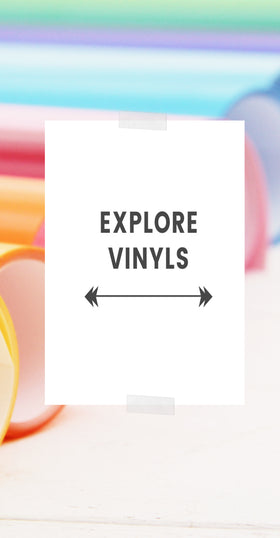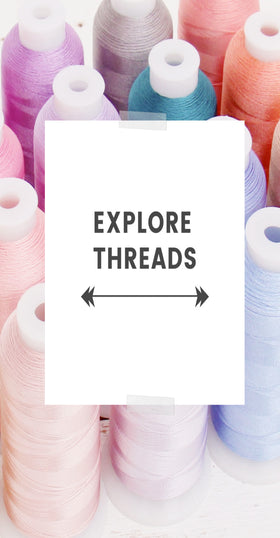Arrives in 2-6 Days

How To Iron On Vinyl
Ready to make some craft magic with iron on vinyl or heat transfer vinyl (HTV)? (Yes, they are the same) Here's everything you need to know from A to Z about creating your own customized t-shirts and crafts with iron-on vinyl. Let's get crafty!

Understanding HTV
What is HTV anyway?
Heat transfer vinyl, also lovingly known as iron-on vinyl, t-shirt vinyl, or simply HTV, is a unique vinyl that sticks to fabric when heat is applied. It's different from adhesive vinyl, which is sticky from the start. The HTV comes with a shiny front (the carrier sheet you peel off after ironing) and a matte back (the side you'll cut and the one with the heat-activated adhesive).
What if I'm not working with fabric?
Fret not! There are other types of vinyl that stick to glass, plastic, walls and more. You might want to explore our adhesive vinyl options.
Getting Down to Brass Tacks
At what temperature should I iron HTV?
This depends on the type of HTV you're using. For instance, with ThreadArt HTV, you'll need to set your iron between 300-330 degrees Fahrenheit. Our vinyl temperature and peel instruction can be found here. Other brands may have different temperature requirements, so always check beforehand.
What if my iron doesn't show the temperature?
No worries! You can do a simple test with a scrap of fabric or an old t-shirt to find the right setting. I have found that the high cotton setting to low linen setting works well with my iron, which is probably around 300 degrees Fahrenheit.
What cutting settings should I use for HTV?
Remember, every blade, machine, and mat are different. Always do a test cut before proceeding with your entire project. But for most machine like Cricut or Silhouette, you will choose iron-on vinyl, or heat transfer vinyl, or just vinyl.

What size should my design be?
Always measure your design before cutting! Below is a helpful list of sizes that work well for most t-shirt projects. Make sure to adjust these sizes to match your specific project:
- Adult t-shirt front size: 11" x 11"
- Fitted adult or ladies t-shirt size: 9" x 9"
- Youth t-shirt size: 7" x 7"
- Toddler t-shirt size: 5" x 5"
- Baby t-shirt small: 4" x 4"
- Sleeve measurement: 2" x 11"
- Pocket size: 4" x 4"
ThreadArt iron on vinyl is 20" wide and sold by the yard for even larger project such as table runners, banners, and laundry bags. It also reduces waste when you are cutting multiples of a single design.
Frequently Asked Questions
What can I iron on?
Almost anything that can withstand the heat of an iron. For beginners, you can try t-shirts, koozies, baby onesies, blankets, pillowcases, tote bags, and napkins.
Will the vinyl stay on fabric after several washes?
Definitely! Depending on the type of HTV, your iron-on design can outlive your t-shirt! Just remember to turn your garment inside out, wash it on cold, and avoid the dryer.
Is it better to use a heat press or an iron?
A heat press does have its advantages. It heats evenly, reducing the risk of peeling edges. If you have access to one, use it! But if you don't a household iron will work as well.

What additional supplies do I need?
You'll need:
- A cutting machine
- Cutting mat
- An iron or a heat press
- Weeding tools (tweezers will do!)
- Scissors
- A teflon sheet or parchment paper
- An ironing board or heat protective surface
- The fabric or material you're working on
Do I need to flip my design?
Yes, always mirror or flip your design before cutting. This ensures that when you look at your design applied to the surface, it reads correctly.
Do I need transfer paper or a squeegee?
Good news – you don't! The HTV's carrier sheet acts like transfer paper, and you don't need a squeegee for HTV.
Should I pre-wash my fabric?
Pre-washing fabric is always recommended if you have time. It removes any dust and ensures your HTV sticks better to a clean surface. Skip the fabric softener though!
Now, go forth and create amazing crafts with your newfound heat transfer vinyl knowledge! Before you know it, you'll be an HTV wizard. Happy crafting!


